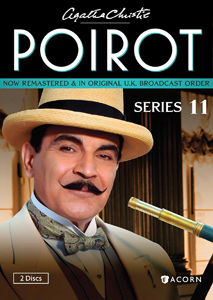“Agatha Christie’s Poirot” has never looked better than in Season 11 (2008-09, ITV, A&E), as we’re invited into the cluttered boarding house of “Mrs. McGinty’s Dead,” the “Harry Potter”-esque girls school of “Cat Among the Pigeons” and the vibrant Middle Eastern archaeological site of “Appointment with Death.”
Zoe Wanamaker’s author Ariadne Oliver and David Yelland’s butler Georges had appeared in the previous season, but they feel fully integrated here, and it’s no accident that the two episodes where they both appear are the season’s two best. Poirot seems less lonely, which is nice.
While the casting and production values can’t be quibbled with, the scripts can be. To be fair, we’re now dealing with novels that had been passed over in 10 previous seasons, in many cases because they are hard to translate. Christie’s “Third Girl,” for instance, is extremely 1960s-centered, but for the show’s continuity it has to be placed in 1937.

“Agatha Christie’s Poirot” Season 11 (2008-09)
ITV, A&E; four episodes
Directors: Ashley Pearce, James Kent, Dan Reed
Writers: Nick Dear, Mark Gatiss, Peter Flannery, Guy Andrews
Starring: David Suchet, Zoe Wanamaker, David Yellen
Christie’s “Appointment with Death,” meanwhile, is a subtle piece of psychology as we learn the hold the evil Lady Boynton has over her young-adult children. People’s inner lives are not easy to translate to the screen, so the script goes broader – so broad that by the end nothing makes sense! It’s a popular pick for the worst episode of the entire series (despite the fact that it’s among the best-looking episodes).
Here are my rankings for the four episodes of Season 11. (SPOILERS FOLLOW.)
1. “Mrs. McGinty’s Dead” (episode 1, written by Nick Dear)
Director Ashley Pearce’s episode smoothly blends two distinct tones – the horror of an innocent man being convicted of murder, and the absurdity of Poirot’s and Ariadne’s dealings with humanity. That latter issue is further split into two tones, with many witnesses/suspects being hostile toward Poirot, whereas Ariadne’s work with a playwright is a chuckle-worthy meta-commentary on how screen adaptations altered Christie’s works.
To be fair, the screen and page are different, and ironically (or appropriately), “McGinty” is one of the rare stories that plays better with the high drama of performances and mood-setting music (composer Stephen McKeon is the ep’s unsung hero) than it does via the written word.
In the novel, it’s convoluted how Poirot must figure out which on-the-lam criminal (as highlighted in a tabloid newspaper) from the distant past has resurfaced in the village of Broadhinny under a new identity, and then killed Mrs. McGinty, who knew their secret. In Dear’s script, it’s still complex, but behaviors ring true as several characters aggressively hide their secrets from Poirot. The detective remains polite among people’s insults toward him (as a filthy foreigner) and the late title character (merely a charwoman), but Suchet communicates that even Poirot’s patience is being strained.

Humor comes from the frustrated Ariadne working with a playwright who wants to turn her fictional detective Sven Hjerson into an entirely different person. And Dear preserves Poirot’s annoyance at the boarding house with multiple drafty windows plus things that would annoy anyone, such as the family dog hovering over the host’s preparation of vegetables. Broadhinny would be an intolerable place if it was real, but it’s a vibrantly teeming locale for a high-stakes mystery.
Novel: “Mrs. McGinty’s Dead” (1952)
2. “Third Girl” (3, Peter Flannery)
I was skeptical about this adaptation but ended up liking it, largely because Jemima Rooper turns the potentially ridiculous Norma Resterick – who believes she has committed multiple murders, similar to framed man in Season 4’s “The ABC Murders” — into a sympathetic character. Although Poirot’s butler Georges and author friend Ariadne had been in previous episodes – introduced rather randomly – by now they slot smoothly into Poirot’s life, and while they aren’t exactly the Hastings-Japp-Lemon trio, they are close.
This episode is among the most awkward to move from the Sixties to the Thirties because Christie is so engaged in analyzing the new domestic situation of independent-minded bachelorettes living together in flats – the First Girl as the lease-holder and the Second and Third girls paying lower rents for smaller bedrooms. While it’s not impossible that three single women would share a flat in the 1930s, when Ariadne speaks of it as a London trend, that’s inaccurate for the time.
Most everything else translates well, including the casting of Rooper and similar looking Matilda Sturridge, whose Frances Cary resembles Norma for a reason. The translation of David Baker from a beat-poet artist to a painter with a posh studio plays OK, although it makes it difficult for Tom Mison to play the misleading menace of Christie’s book.
With so many characters, “Third Girl” veers toward telling rather than showing, but since the telling comes via Poirot exchanging theories with Ariadne, the banter is enjoyable. And the budding relationship between Poirot and this unstable young woman who initially rejects his help due to him being “too old” is heartfelt. A masterpiece, non, but it’s quite good for being an unnatural translation.
Novel: “Third Girl” (1966)
3. “Cat Among the Pigeons” (2, Mark Gatiss)
In his “Poirot” debut, writer Gatiss – also an actor, popping up in “Appointment with Death” — shows a knack for teasing spooky vibes out of Christie’s novels, with help from the plot that features multiple screams ringing across the prep girls school campus, and ominous music by McKeon.
At the same time, Gatiss is faithful to the material, with most of the teachers and students appearing as I pictured them. Especially impressive is Amara Karan as Princess Shiasta, who isn’t quite who she claims to be – but the actress pulls off both the fakery and the true self.
The architecture and atmosphere have a slight “Harry Potter” atmosphere, appealing during that saga’s heyday in 2008. One quibble is that Natasha Little’s Miss Shapland doesn’t have the dynamism we’d hope for in an adaptation. The secretary to the headmistress is rather flat until she’s revealed as the killer, at which point she’s a cartoonish villain.
Novel: “Cat Among the Pigeons” (1959)
4. “Appointment with Death” (4, Guy Andrews)
Shot in Morocco, this is on the short list of the best-looking “Poirot” episodes. We get a thriving archeological dig with vibrant surrounding rows of tents for visitors. While Poirot looks as miserable around all this sand as he did in Season 5’s “The Adventure of the Egyptian Tomb” and Season 8’s “Murder in Mesopotamia,” to me this seems like a nicer place to visit.
As long as you avoid Lady Boynton, played as nastily by Cheryl Campbell as Christie writes her on the page. An excellent cast of adopted relatives and helpers forms the robust suspect list; with the possible exception of Season 6’s “Hercule Poirot’s Christmas,” never before has it been so obvious who the murder victim will be. While it’s nice to see Tim Curry, the adaptation-only creation of Mr. Boynton, the archaeologist, makes little sense; how could anyone stand to be married to this woman for one moment, even if it allows for funding of his digs?
No denouement of a “Poirot” episode runs further off the rails than “Appointment with Death.” While the killers’ convoluted and risky plan makes sense insofar as they wanted Mrs. Boynton to suffer before dying, the red herrings (“red fish,” as Poirot says) around this case are insane. The questions of why people do certain things and how Poirot learns about their actions go utterly unanswered. Infamously, there’s a child-trafficking nun! (Presumably not an actual nun, but we don’t learn the details.)
“Appointment with Death” ends up with the bizarre status of being among both “Poirot’s” best-looking and worst-written episodes.
Novel: “Appointment with Death” (1938)
IMDb top 250 trivia
- “Poirot” ranks at No. 151 on the list with an 8.6 rating.
- “Cat Among the Pigeons” (7.9) is the season’s most popular episode and “Appointment with Death” (7.5) the least popular.
Sleuthing Sunday reviews the works of Agatha Christie, along with other new and old classics of the mystery genre.

